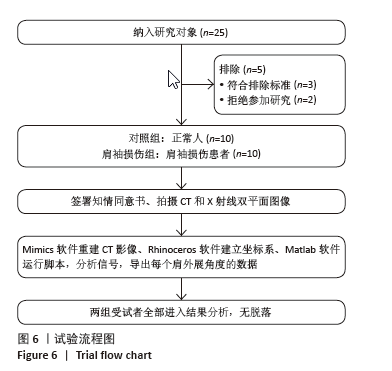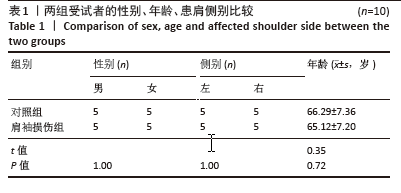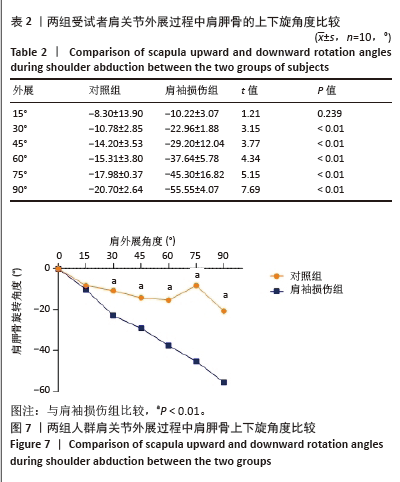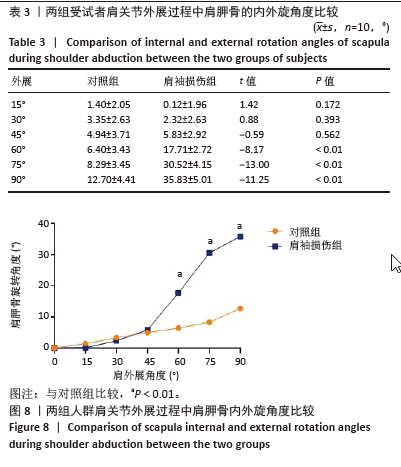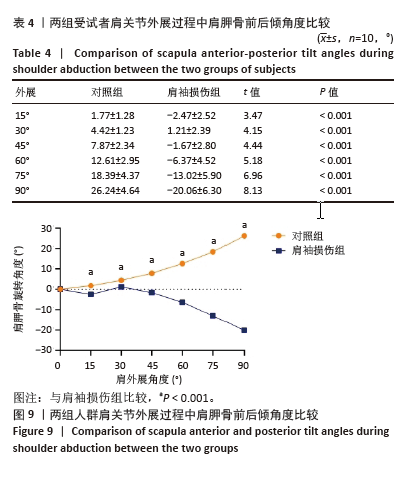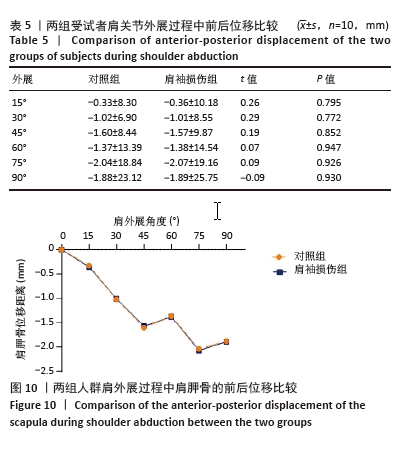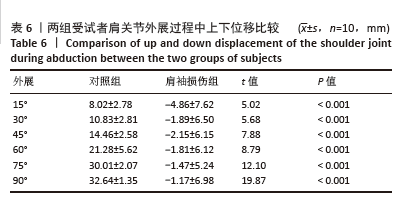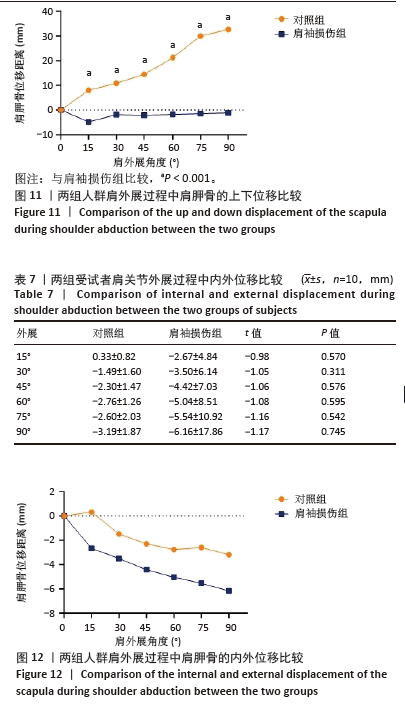[1] HOPEWELL S, KEENE DJ, MARIAN IR, et al. Progressive exercise compared with best practice advice, with or without corticosteroid injection, for the treatment of patients with rotator cuff disorders (GRASP): a multicentre, pragmatic, 2 x 2 factorial, randomised controlled trial. Lancet. 2021;398(10298):416-428.
[2] 王刚, 高绪仁, 仇尚, 等. 肩峰覆盖三维测量与退变性肩袖全层撕裂的关系[J]. 中国组织工程研究,2024,28(36):5773-5778.
[3] 申勇, 刘时璋, 翟腾飞, 等. 中老年退行性肩袖撕裂患者肩峰指数、肩肱距离与年龄的相关性[J]. 中国组织工程研究,2023,27(31): 5040-5045.
[4] ZHAO J, ZENG L, LIANG G, et al. Risk factors for symptomatic rotator cuff tears: a retrospective case-control study. Front Med (Lausanne). 2023;10:1321939.
[5] LOWRY V, LAVIGNE P, ZIDAROV D, et al. A Systematic Review of Clinical Practice Guidelines on the Diagnosis and Management of Various Shoulder Disorders. Arch Phys Med Rehabil. 2024; 105(2):411-426.
[6] BARCIA AM, MAKOVICKA JL, SPENCINER DB, et al. Scapular motion in the presence of rotator cuff tears: a systematic review. J Shoulder Elbow Surg. 2021;30(7):1679-1692.
[7] HUANG S, HUANG L, XIE F, et al. Design and Testing of a Dynamic Orthosis to Reduce Glenohumeral Subluxation With Omnidirectional Shoulder Motion. IEEE Trans Biomed Eng. 2023;70(6):1815-1825.
[8] KOZONO N, OKADA T, TAKEUCHI N, et al. Dynamic kinematics of the glenohumeral joint in shoulders with rotator cuff tears. J Orthop Surg Res. 2018;13(1):9.
[9] BURTON W, CRESPO IR, ANDREASSEN T, et al. Fully automatic tracking of native glenohumeral kinematics from stereo-radiography. Comput Biol Med. 2023;163:107189.
[10] MULLA DM, HODDER JN, MALY MR, et al. Glenohumeral stabilizing roles of the scapulohumeral muscles: Implications of muscle geometry. J Biomech. 2020;100:109589.
[11] KOZONO N, OKADA T, TAKEUCHI N, et al. In vivo kinematic analysis of the glenohumeral joint during dynamic full axial rotation and scapular plane full abduction in healthy shoulders. Knee Surg Sports Traumatol Arthrosc. 2017;25(7):2032-2040.
[12] LONGO UG, RISI AL, CANDELA V, et al. Scapular Kinematics and Patterns of Scapular Dyskinesis in Rotator Cuff Tears: A Prospective Cohort Study. J Clin Med. 2023;12(11):3841.
[13] WAGNER ER, HUSSAIN ZB, KARZON AL, et al. The Scapula: The Greater Masquerader of Shoulder Pathologies. Instr Course Lect. 2024;73: 587-607.
[14] GIOVANNETTI DSE, CIOLLI G, MOCINI F, et al. Evaluation of the range of motion of scapulothoracic, acromioclavicular and sternoclavicular joints: State of the art. Shoulder Elbow. 2023;15(2):132-139.
[15] 谭菁华, 薛静波, 谢勇, 等. 光学三维运动捕捉系统用于生物力学测试的精准度分析[J]. 中国组织工程研究,2022,26(12):1822-1827.
[16] SANDBERG OH, KARRHOLM J, OLIVECRONA H, et al. Computed tomography-based radiostereometric analysis in orthopedic research: practical guidelines. Acta Orthop. 2023;94:373-378.
[17] WADE L, NEEDHAM L, MCGUIGAN P, et al. Applications and limitations of current markerless motion capture methods for clinical gait biomechanics. PeerJ. 2022;10:e12995.
[18] SETLIFF JC, ANDERST WJ. A scoping review of human skeletal kinematics research using biplane radiography. J Orthop Res. 2024;42(5):915-922.
[19] YUEN J, ESFANDIARPOUR F, LEBRUN CM, et al. Using Dual-Orthogonal Fluoroscopy and CT to Assess the Relationship Between Knee Morphology and Patellar Kinematics in Patients With Patellofemoral Pain. Cureus. 2023;15(8):e44139.
[20] 袁施挺, 竺思远, 谷雪莲, 等. 正常国人盂肱关节在不同手臂抬高平面的运动学研究[J]. 医用生物力学,2022,37(2):317-322.
[21] NYOGER Z, SZAKALY N, MOLNAR CA, et al. [Scapula dyskinesis in medium size full-thickness supraspinatus muscle tears]. Orv Hetil. 2023;164(31):1213-1221.
[22] GIRI A, O’HANLON D, JAIN NB. Risk factors for rotator cuff disease: A systematic review and meta-analysis of diabetes, hypertension, and hyperlipidemia. Ann Phys Rehabil Med. 2023;66(1):101631.
[23] KIBLER WB, UHL TL, MADDUX JW, et al. Qualitative clinical evaluation of scapular dysfunction: a reliability study. J Shoulder Elbow Surg. 2002;11(6):550-556.
[24] SONG HE, OH KS, YOON JP, et al. Improvement in scapular dyskinesis after rotator cuff repair and subacromial decompression. Knee Surg Sports Traumatol Arthrosc. 2021;29(12):3961-3970.
[25] DEORIO JK, COFIELD RH. Results of a second attempt at surgical repair of a failed initial rotator-cuff repair. J Bone Joint Surg Am. 1984;66(4): 563-567.
[26] WU G, VAN DER HELM FC, VEEGER HE, et al. ISB recommendation on definitions of joint coordinate systems of various joints for the reporting of human joint motion--Part II: shoulder, elbow, wrist and hand. J Biomech. 2005;38(5):981-992.
[27] MIURA Y, KAI Y, MORIHARA T, et al. Three-dimensional Scapular Kinematics During Arm Elevation in Massive Rotator Cuff Tear Patients. Prog Rehabil Med. 2017;2:20170005.
[28] CROCI E, HESS H, GENTER J, et al. Severity of rotator cuff disorders and additional load affect fluoroscopy-based shoulder kinematics during arm abduction. J Orthop Traumatol. 2024;25(1):30.
[29] ROBERT-LACHAINE X, ALLARD P, GODBOUT V, et al. Scapulohumeral rhythm relative to active range of motion in patients with symptomatic rotator cuff tears. J Shoulder Elbow Surg. 2016;25(10): 1616-1622.
[30] LEONG HT, NG GY, CHAN SC, et al. Rotator cuff tendinopathy alters the muscle activity onset and kinematics of scapula. J Electromyogr Kinesiol. 2017;35:40-46.
[31] BAUMER TG, CHAN D, MENDE V, et al. Effects of Rotator Cuff Pathology and Physical Therapy on In Vivo Shoulder Motion and Clinical Outcomes in Patients With a Symptomatic Full-Thickness Rotator Cuff Tear. Orthop J Sports Med. 2016;4(9): 2325967116666506.
[32] CHOI M, CHUNG J. Biomechanical and functional analysis of the shoulder complex and thoracic spine in patients with subacromial impingement syndrome: A case control study. Medicine(Baltimore). 2023;102(4):e32760.
[33] KIJIMA T, MATSUKI K, OCHIAI N, et al. In vivo 3-dimensional analysis of scapular and glenohumeral kinematics: comparison of symptomatic or asymptomatic shoulders with rotator cuff tears and healthy shoulders. J Shoulder Elbow Surg. 2015;24(11):1817-1826.
[34] TEIXEIRA DC, ALVES L, GUTIERRES M. The role of scapular dyskinesis on rotator cuff tears: a narrative review of the current knowledge. EFORT Open Rev. 2021;6(10):932-940.
[35] KIBLER WB, LUDEWIG PM, MCCLURE PW, et al. Clinical implications of scapular dyskinesis in shoulder injury: the 2013 consensus statement from the ‘Scapular Summit’. Br J Sports Med. 2013;47(14):877-885.
[36] KOLK A, DE WITTE PB, HENSELER JF, et al. Three-dimensional shoulder kinematics normalize after rotator cuff repair. J Shoulder Elbow Surg. 2016;25(6):881-889.
[37] UEDA Y, TANAKA H, MORIOKA S, et al. Comparison of scapular upward rotation during arm elevation in the scapular plane in healthy volunteers and patients with rotator cuff tears pre- and post-surgery. Clin Biomech (Bristol, Avon). 2019;63:207-213.
[38] REUTHER KE, TUCKER JJ, THOMAS SJ, et al. Effect of scapular dyskinesis on supraspinatus repair healing in a rat model. J Shoulder Elbow Surg. 2015;24(8):1235-1242.
[39] SONG HE, OH KS, YOON JP, et al. Improvement in scapular dyskinesis after rotator cuff repair and subacromial decompression. Knee Surg Sports Traumatol Arthrosc. 2021;29(12):3961-3970.
[40] TANIOKA R, ITO H, TAKASE K, et al. Usefulness of 2D Video Analysis for Evaluation of Shoulder Range of Motion during Upper Limb Exercise in Patients with Psychiatric Disorders. J Med Invest. 2022; 69(1.2):70-79.
[41] ALGHAMDI A, MADAN S, SHUWEIHDI F, et al. “The accuracy of the EOS imaging system to assess hip abnormalities in adolescents and adults:” a systematic review and meta-analysis. Skeletal Radiol. 2024;53(1): 29-42. |
